A few months ago, I was driving home after a long day when I felt that dreaded wobble in my steering wheel. Sure enough, I had a flat tyre—and my first thought was, does car insurance cover tyres in a situation like this? I’ve been through enough insurance claims to know that tyre coverage isn’t always straightforward. Over the years, I’ve learned the difference between when your policy will step in—like after an accident, vandalism, or certain road hazards—and when you’re on your own for repairs. In this guide, I’ll share what I’ve discovered about flat tyres, slashed tyres, and other kinds of tyre damage so you know exactly what’s covered, what’s not, and how to avoid expensive surprises. Let’s dive in before your next road trip turns into a roadside headache.
Why Tyre Coverage Confuses So Many Drivers
I’ve learned the hard way that tyre coverage is one of those topics that catches drivers off guard. On the surface, it sounds simple—if something happens to your car, your insurance should pay for it, right? But tyres are in their own little grey area. Sometimes they’re covered, sometimes they’re not, and the rules can feel as tricky as reading fine print with a flashlight.
Part of the confusion comes from how car insurance is set up. Most people know about liability insurance, but they don’t realize that tyres usually only come into play under collision or comprehensive coverage—and even then, only in certain situations. If your tyre damage is linked to a bigger covered event, like an accident or vandalism, your insurer might help. But if it’s just a flat from wear and tear, you’re on your own. In short, car insurance doesn’t treat tyres like it does the rest of your car’s bodywork.
I remember once getting into a heated back-and-forth with my insurer after a deep pothole left my rim bent and my tyre shredded. I thought it was an obvious claim, but they saw it differently because it didn’t meet the policy’s accident definition. That’s when I realized tyre coverage isn’t just about what happened—it’s also about how it happened. Knowing this can save you from a nasty surprise when you file a claim.
The Short Answer – Does Car Insurance Cover Tyres?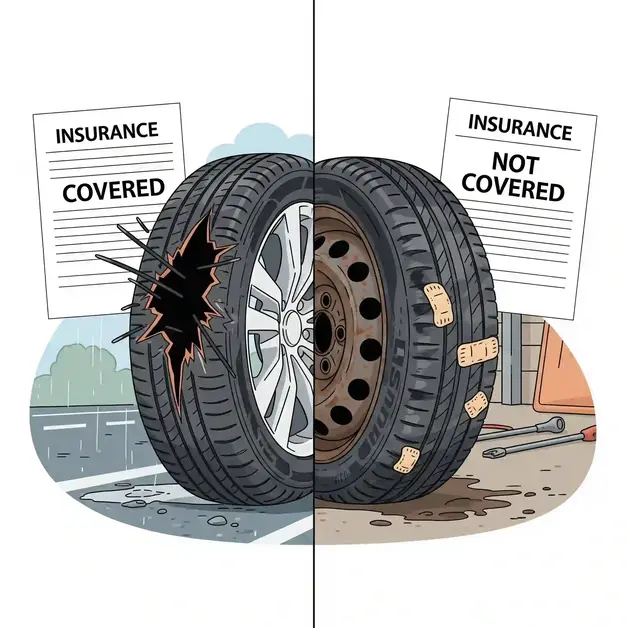
The quick truth is Car insurance can cover tyres, but only in certain situations. It’s not a “yes or no” answer—it’s more of a “sometimes, depending on why they’re damaged.” If your tyres are ruined in an accident, stolen, slashed, or damaged by a covered natural event, you might be in luck. But if they go flat from wear and tear or a slow leak, you’re probably footing the bill yourself.
Think of it this way—tyres are only covered when they’re part of a bigger insured event. For example, I once hit a fallen ladder on the highway (yes, a ladder!) that shredded my front tyre. Because it counted as road debris damage under my comprehensive coverage, my insurer paid for it. On the flip side, the time my tyre went flat in my driveway from a nail? That was all me, because it didn’t tie into any covered incident.
Here’s the key difference most people miss:
- Liability insurance never covers tyres—it only pays for damage you cause to others.
- Collision coverage can cover tyres if they’re damaged in an accident.
- Comprehensive coverage can step in for theft, vandalism, or certain natural disasters.
If you only have liability coverage, no matter what happens to your tyres, you’re paying out of pocket. But with collision or comprehensive, there’s a chance you’re covered—just remember your deductible still applies.
When Tyres Are Covered by Insurance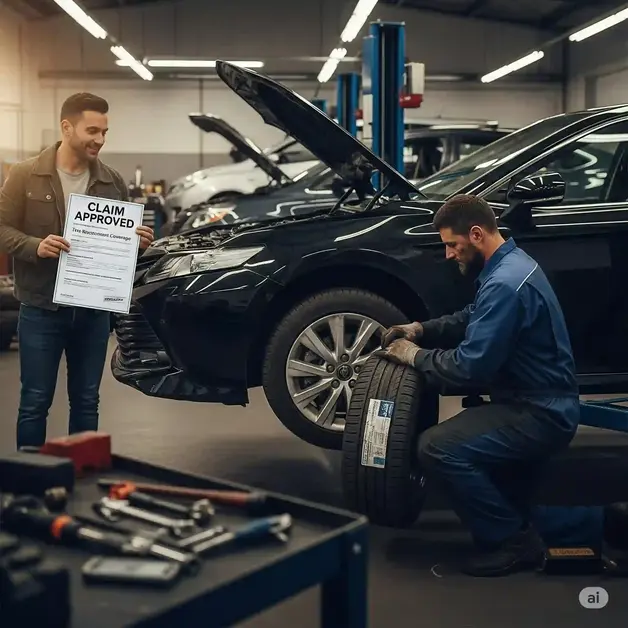
If there’s one thing I’ve learned, it’s this—tyres are covered when the damage is tied to a bigger insured event. It’s not about the tyre itself, but the “why” behind the damage. If that “why” fits your policy, your insurer can step in. I’ve had claims paid when my tyres were part of a covered accident, but I’ve also been left paying out of pocket when the cause didn’t make the cut.
After an Accident (Collision Coverage)
When a tyre gets damaged in a crash, collision coverage can help pay to repair or replace it. I remember sliding on black ice one winter and clipping a curb hard enough to pop my front tyre and bend the rim. My collision coverage kicked in because the tyre damage was part of the accident. Just know—you’ll still need to pay your deductible before insurance covers the rest.
Short answer: Car insurance can cover tyres after an accident if you have collision coverage.
Damage from Theft or Vandalism (Comprehensive Coverage)
Comprehensive coverage isn’t just for hailstorms and falling tree branches—it can also help when people do the damage. A friend of mine came outside one morning to discover that someone had slashed all four of his tyres. Because he had comprehensive coverage, the insurance company paid for new tyres after he filed a police report.
Short answer: Insurance will cover slashed tyres if you have comprehensive coverage and file a proper claim.
Damage from Certain Natural Events
Storms, floods, and even wildfire embers can ruin tyres. I once parked under a tree during a windstorm and came back to find a heavy branch had crushed my back wheel and tyre. My comprehensive coverage handled it without fuss.
Short answer: Tyres can be covered if they’re damaged by a natural event under comprehensive coverage.
When Tyres Are Not Covered by Insurance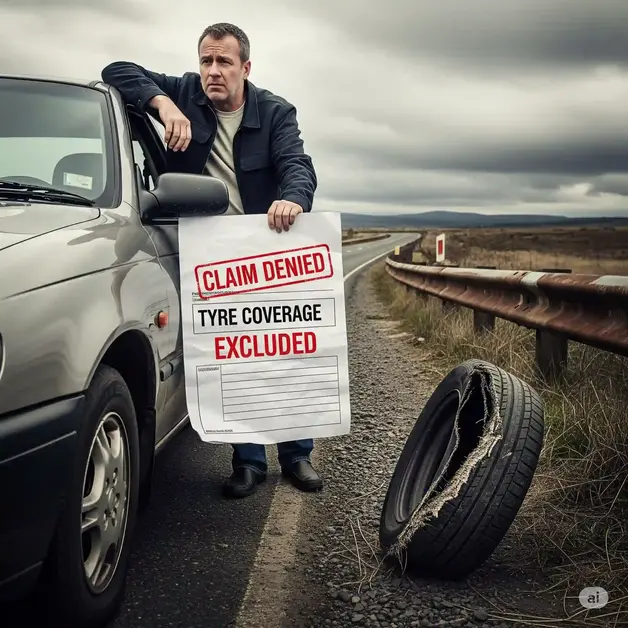
I wish I could tell you that car insurance always steps in when you’re stuck with a flat, but the truth is, most tyre problems don’t make the cut. Tyres are often seen as “wear items,” just like brake pads or wiper blades. That means if they fail because of age, neglect, or everyday use, the cost usually lands on you. Put simply: insurance only covers tyres when the damage ties to a bigger insured event—otherwise, you’re footing the bill.
Flat Tyres from Wear and Tear
You might be wondering—does car insurance cover a flat tyre that’s worn out from regular driving? The short answer is no. If your tread is worn down or your tyre gives out from simple aging, insurers see that as maintenance. I once had a blowout on the highway because I pushed my tyres a little too long past their prime. I crossed my fingers that my insurer would step in, but they made it clear—tyre upkeep is on me.
Short answer: Insurance won’t cover a flat tyre caused by normal wear or poor maintenance—it’s up to you to replace it.
Punctures or Minor Damage
What about something smaller, like a nail or a slow leak? Here’s where a lot of drivers get caught off guard. Most policies won’t step in for a little puncture because it doesn’t count as an accident or major event. I learned this the hard way when I found a screw in my tyre after a grocery run. I had to pay for the patch myself.
That’s when I realized keeping a tyre repair kit in the trunk can save both time and money.
Short answer: Small punctures or leaks aren’t covered by insurance, but many tyre shops can patch them cheaply.
Overloading or Misuse
Another situation where you’re on your own is when tyres fail due to overloading or misuse. For example, if you’re hauling way over your vehicle’s weight limit or taking your sedan off-road where it’s not designed to go, don’t expect insurance to help if the tyre blows. Insurers view that as driver misuse, not an insurable accident.
I once helped a buddy who shredded his tyre after trying to carry half a construction site in his pickup bed. His insurer laughed it off—it wasn’t a covered loss.
Short answer: Insurance doesn’t cover tyre damage from overloading, misuse, or off-road driving—it’s considered driver responsibility.
Does Car Insurance Cover a Flat Tyre on the Road?
Getting a flat tyre on the road is one of those moments that makes your heart sink. I’ve had it happen more than once—usually at the worst time, like rushing home late or on a road trip hours from anywhere. The big question most people ask is: does car insurance cover a flat tyre while you’re driving? The short answer is no, not on its own. Insurance doesn’t usually pay to fix or replace a tyre that goes flat from a nail, a slow leak, or normal wear.
Roadside Assistance Add-On Options
Here’s where things get a little better. While standard car insurance won’t pay for a flat tyre by itself, many insurers offer roadside assistance as an optional add-on. This doesn’t cover the tyre cost, but it can save you the hassle of being stranded. Roadside assistance usually sends someone to put on your spare, patch a minor puncture, or tow you to the nearest shop.
In simple terms: roadside assistance covers the service, not the tyre itself. Think of it as paying for the helping hand, not the rubber.
My Experience Using Roadside Assistance
I’ll never forget one evening when I ran over a sharp piece of metal on a dark highway. My front tyre went flat instantly, and I was stuck on the shoulder with trucks flying past. Instead of wrestling with the jack myself, I called my insurer’s roadside assistance line. Within 40 minutes, a mechanic showed up, swapped my spare on, and I was back on the road. I still had to pay for a new tyre the next day, but in that moment, roadside assistance felt like a lifesaver.
If you don’t already have roadside coverage, carrying a portable air compressor or emergency roadside kit is a smart backup.
So while insurance didn’t cover the tyre, the roadside service turned a stressful night into a quick detour instead of a disaster.
How Towing and Tyre Service Works Under Certain Plans
Not all roadside assistance is created equal. Some basic plans only cover towing, while others send help for tyre changes, fuel delivery, or even jump starts. A few insurers partner with national roadside clubs, so the coverage is similar to what you’d get with AAA. Always check the fine print—some plans only tow you to the nearest garage, while others may cover longer distances.
Bottom line: roadside assistance can get you out of a jam with a flat tyre, but the cost of repair or replacement still comes out of your pocket.
Optional Add-Ons That Protect Tyres
Here’s the thing: standard car insurance only goes so far. If you want peace of mind every time you hit a pothole or pick up a nail, you may need to look at optional add-ons that protect tyres. These aren’t included in a regular policy, but they can save you money (and stress) if you deal with rough roads, long commutes, or bad luck like I often seem to have.
Short answer: add-ons like tyre and rim protection or road hazard coverage can fill the gaps your regular insurance leaves open.
Tyre and Rim Protection Plans
A tyre and rim protection plan is like insurance’s little cousin, but it focuses only on your wheels. These plans usually cover repairs or replacements if your tyres or rims are damaged by potholes, nails, glass, or other hazards. I had one through a dealer once, and it paid off when a nasty pothole bent my rim and blew the tyre—something my normal car insurance wouldn’t touch.
To put it simply: tyre and rim protection pays for the damage itself, not just the service to get you back on the road.
Road Hazard Coverage
Road hazard coverage is similar, but sometimes offered directly by tyre shops or retailers instead of insurers. Buy a set of tyres, and they might sell you a road hazard warranty that covers punctures, blowouts, or even replacements if the tyre can’t be fixed. I’ve used one of these before, and it felt great walking into the shop, showing my warranty, and leaving with a brand-new tyre without opening my wallet.
Short answer: road hazard coverage helps cover repairs or replacements when tyres are damaged by everyday hazards like nails, potholes, or debris.
How These Differ from Standard Car Insurance
The key difference is that these add-ons focus on the tyres themselves, while car insurance only steps in when the damage is tied to a bigger covered event. Think of it like the difference between having a friend who helps only in big emergencies versus one who’s there even for the small stuff. If you drive a lot, live in an area with bad roads, or just hate surprise bills, these add-ons can make a lot of sense.
Bottom line: optional tyre coverage fills the everyday gaps your main car insurance doesn’t cover.
My Personal Tips for Avoiding Tyre-Related Insurance Surprises
Over the years, I’ve learned that tyre trouble doesn’t just ruin your day—it can also test your wallet if you’re not careful with insurance. The truth is, most car insurance won’t cover flat tyres or wear and tear, so prevention is your best bet. The short answer? Keep your tyres in good shape and know what your policy actually says.
One habit that’s saved me is checking tyre pressure at least once a month. It sounds boring, but underinflated tyres wear faster and are more likely to blow out. A quick check at the gas station takes two minutes, and it can save you from a denied claim later. In simple terms: good upkeep means fewer headaches with both tyres and insurers.
Having your own digital tyre pressure gauge makes it even easier—you don’t need to rely on gas station pumps that are often inaccurate.
Another tip—document everything when damage happens. I once hit a chunk of debris on the highway that shredded my tyre. Instead of panicking, I snapped photos right away and filed a claim under comprehensive coverage. The pictures were the proof I needed, and the claim went through without hassle. Short answer? Always gather evidence, even if you’re unsure the insurer will cover it.
Reading the fine print is something I used to ignore, but it’s critical. Some policies exclude tyre damage from potholes, while others might cover it under certain conditions. I found this out the hard way after assuming “full coverage” meant everything. Spoiler: it doesn’t. The takeaway here is simple—know exactly what your policy says before you need it.
Finally, invest in roadside assistance if it’s not already on your plan. I can’t count how many times that little add-on saved me, especially when I got stuck with a flat late at night. It doesn’t replace tyre coverage, but it gives you peace of mind knowing help is one call away. In short: a small monthly fee beats being stranded on the side of the road.
FAQs – Quick Answers to Common Questions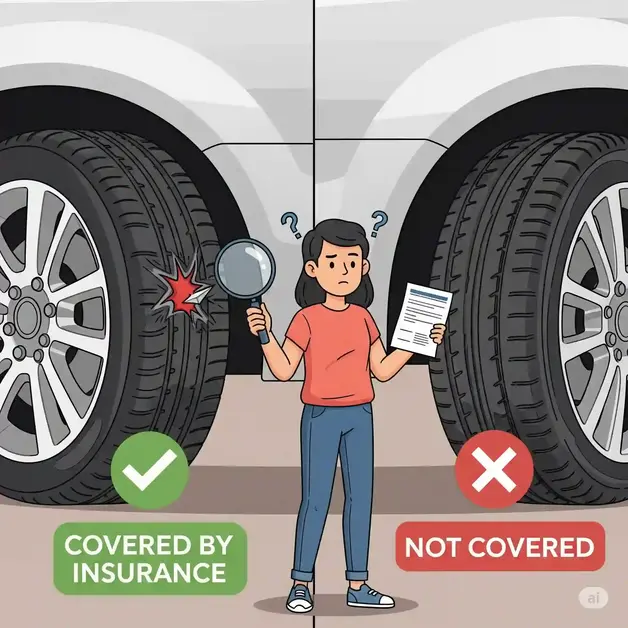
Q: Does car insurance cover flat tyres?
A: No, car insurance does not cover flat tyres from wear and tear. It may only cover flats caused by an accident, theft, or other covered events.
Q: Does car insurance cover tyre damage from potholes?
A: Tyre damage from potholes may be covered under collision insurance, but normal wear or minor damage from rough roads is not covered.
Q: Will insurance cover slashed tyres?
A: Yes, most comprehensive car insurance covers slashed tyres caused by vandalism, but you may still need to pay your deductible first.
Q: Does insurance cover flat tyres from road debris?
A: If road debris damages your tyre during an accident, collision or comprehensive may apply. Small punctures from nails or glass are not covered.
Q: Does renters or homeowners insurance cover stolen tyres?
A: Yes, if your tyres or rims are stolen, renters or homeowners insurance may cover them, though you may still need to pay your deductible.
Final Thoughts – Should You Pay Extra for Tyre Coverage?
If you’re someone who wants total peace of mind, tyre coverage can feel like a safety net worth paying for. But if you keep up with maintenance and rarely face high-risk driving, you might be fine without it. For me, it only proved valuable after a vandalism claim—before then, I didn’t see the need. Think about your driving habits, budget, and how much “what if” protection really matters to you.
For everyday peace of mind, I recommend keeping a compact tyre inflator in your car. It’s one of those small investments that can save a big headache later.

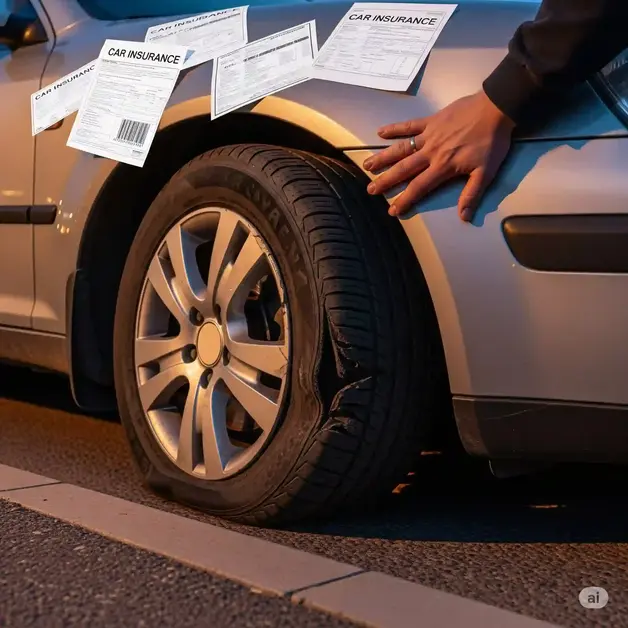
1 thought on “Does Car Insurance Cover Tyres? Exclusive, Scary Truth Revealed”